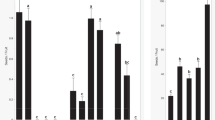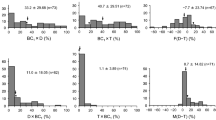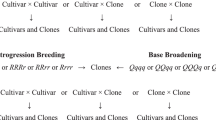Summary
Endosperm failure is considered the primary reason for the lack of success in intra-and interspecific crosses. The Endosperm Balance Number (EBN) hypothesis is a unifying concept for predicting endosperm function in intraspecific, interploidy, and interspecific crosses. In the EBN system, every species has an ‘effective ploidy’ (EBN), which must be in a 2:1 maternal to paternal ratio in the endosperm for crosses to succeed. The knowledge of EBN is very useful in the transfer of genes from exotic germplasm, and in the development of new breeding schemes in potato. The paper describes the strategies for introducing 2x(1EBN), 2x(2EBN), 4x(2EBN) and 6x(4EBN) germplasm into the cultivated 4x(4EBN) potato gene pool. A new methodology for producing 4x(4EBN) and 2x(2EBN) chromosome addition lines is also discussed. EBN has evolutionary importance in the origin of tuber-bearing Solanums. The role of the EBN in the origin of diploid and polyploid potato species, and as a barrier for hybridization and speciation of sympatric species within the same ploidy level is demonstrated. The origin of 3x and 5x cultivated tuber-bearing Solanums may also be explained using the EBN concept. EBN has been reported to exist in other plant species: alfalfa, beans, blueberries, rice, soybeans, squashes, tomato, forage legumes, grasses, ornamentals and Datura stramonium. This indicates that EBN may have broad application and could be useful for germplasm transfer and breeding in other crop species.
Similar content being viewed by others
References
Arisumi, T., 1982. Endosperm balance numbers among New Guinea-Indonesian Impatiens species. J. Hered. 73: 240–242.
Brink, R.A., 1952. Inbreeding and crossbreeding in seed development. In: J.W. Cogan (Ed.). Heterosis, Iowa State College Press, Ames, Iowa. pp. 81–97.
Brink, R.A. & D.C. Cooper, 1947. The endosperm in seed development. Bot. Rev. 13: 423–541.
Camadro, E.L. & S.J. Peloquin, 1980. The occurrence and frequency of 2n pollen in three diploid Solanums from northwest Argentina. Theor. Appl. Genet. 56: 11–15.
Carroll, C.P. & M. Borrill, 1965. Tetraploid hybrids from crosses between diploid and tetraploid Dactylis and their significance. Genetica 36: 65–82.
Chujoy, J.E., 1985. Tuber yields of 2x and 4x progeny from 2x × 2x crosses in potatoes; Barriers to interspecific hybridization between Solanum chacoense Bitt. and S. commersonii Dun. Ph.D. Thesis. Univ. Wisconsin-Madison. 129 pp.
Clement, W.M.Jr., 1963. Chromosome relationships in a diploid between M. sativa and M. dzhawakhetica Bordz. Can. J. Genet. Cytol. 5: 427–432.
Cooper, D.C. & R.A. Brink, 1945. Seed collapse following matings between diploid and tetraploid races of Lycopersicon pimpinellifolium. Genetics 30: 376–410.
Correll, D.S., 1962. The potato and its wild relatives. Texas Research Foundation, Renner, Texas. 606 pp.
Dane, F., D.W. Denna & T. Tsuchiya, 1980. Evolutionary studies of wild species in the genus Cucumis. Z. Pflanzenzüchtg. 85: 89–109.
Dhaliwal, H.S., 1977. Basis of difference between reciprocal crosses involving Triticum boeoticum and T. urartu. Theor. Appl. Genet. 49: 283–286.
Dweikat, I.M. & P.M. Lyrene, 1988. Production and viability of unreduced gametes in triploid interspecific blueberry hybrids. Theor. Appl. Genet. 76: 555–559.
Ehlenfeldt, M.K., 1984. The genetics and manipulation of quantitative factors controlling endosperm development. Ph.D. Thesis. University of Wisconsin-Madison. 184 pp.
Ehlenfeldt, M.K. & R.E. HannemanJr., 1984. The use of Endosperm Balance Number and 2n gametes to transfer exotic germplasm in potato. Theor. Appl. Genet. 68: 155–161.
Ehlenfeldt, M.K. & R.E. HannemanJr., 1988a. The transfer of the synaptic gene (sy-2) from the 1EBN Solanum commersonii Dun. to 2EBN germplasm. Euphytica 37: 181–187.
Ehlenfeldt, M.K. & R.E. HannemanJr., 1988b. Genetic control of Endosperm Balance Number (EBN)—Three additive loci in a threshold system. Theor. Appl. Genet. 75: 825–832.
Ehlenfeldt, M.K. & R.E. HannemanJr., 1992. Endosperm dosage requirements in Lycopersicon. Theor. Appl. Genet. 83: 367–372.
Grant, V., 1971. Plant speciation. Columbia University Press, New York. 435 pp.
Harlan, J.R. & J.M.J.de Wet, 1975. On O. Winge and a prayer: the origins of polyploidy. Bot. Rev. 41: 361–389.
Hawkes, J.G., 1962. The origin of Solanum juzepczukii Buk. and S. × curtilobum Juz. et Buk. Z. Pflanzenzücht. 47: 1–14.
Hawkes, J.G., 1979. Evolution and polyploidy in potato species. In: J.G. Hawkes, R.N. Lester & A.D. Skelding (Eds.). The biology and taxonomy of the Solanaceae. Academic Press, London. pp. 637–646.
Hawkes, J.G., 1990. The potato: evolution, biodiversity and genetic resources. Bellhaven Press, London.
Hermsen, J.G.Th. & L.M. Taylor, 1979. Successful hybridization of non-tuberous Solanum tuberosum Lind. and tuberbearing S. pinnatisectum Dun. Euphytica 28: 1–7.
International Potato Center, 1988. Annual Report CIP 1988. Lima, Peru.
Irikura, Y., 1968. Studies on interspecific crosses of tuber-bearing Solanums. I. Overcoming and cross-incompatibility between Solanum tuberosum and other Solanum species by means of induced polyploids and haploids. Res. Bull. Hokkaido Nat. Agr. Exp. Sta. 92: 23–27.
Iwanaga, M. & S.J. Peloquin, 1982. Origin and evolution of cultivated tetraploid potatoes via 2n gametes. Theor. Appl. Genet. 61: 161–169.
Johnston, S.A., 1980. The role and nature of genic balance in endosperm development. Ph.D. Thesis. University of Wisconsin-Madison.
Johnston, S.A. & R.E. HannemanJr., 1980. Support of the Endosperm Balance Number hypothesis utilizing some tuber-bearing Solanum species. Amer. Potato J. 57: 7–14.
Johnston, S.A. & R.E. HannemanJr., 1982. Manipulations of Endosperm Balance Number overcome crossing barriers between diploid Solanum species. Science 217: 446–448.
Johnston, S.A., T.P.M.den Nijs, S.J. Peloquin & R.E. HannemanJr., 1980. The significance of genetic balance to endosperm development in interspecific crosses. Theor. Appl. Genet. 57: 5–9.
Jones, K. & M. Borrill, 1962. Chromosomal status, gene exchange and evolution in Dactylis. III. The role of interploid hybrids. Genetica 32: 296–322.
Kermicle, J.L., 1978. Imprinting of gene action in maize endosperm. In: D.B. Walden (Ed.). Maize breeding and genetics. John Wiley and Sons, New York. pp. 357–371.
Lesins, K., 1961. Interspecific crosses involving alfalfa. I. Medicago dzhawakhetica (Bordz.) Vass. × M. sativa L. and its peculiarities. Can. J. Genet. Cytol. 3: 135–152.
Lin, B.Y., 1984. Ploidy barrier to endosperm development in maize. Genetics 107: 103–115.
MacKey, J., 1970. Significance of mating system for chromosome and gametes in polyploids. Hereditas 66: 165–176.
Maizonnier, D., 1976. Production de tetraploides et de trisomiques naturels chez le Petunia. Annales de 1′ Ammélioration des Plantes 26: 305–318.
Marks, G.E., 1966. The origin and significance of intraspecific polyploidy: Experimental evidence from S. chacoense. Evolution 20: 552–557.
McCoy, T.J. & L.Y. Smith, 1983. Genetics, cytology and crossing behavior of an alfalfa (Medicago sativa) mutant resulting in failure of the postmeiotic cytokinesis. Can. J. Genet. Cytol. 25: 390–397.
Mendiburu, A.O. & S.J. Peloquin, 1977. Bilateral sexual polyploidization in potatoes. Euphytica 26: 573–583.
Muntzing, A., 1930. Über Chromosomenvermehrung in Galeopsis-Kreuzungen und ihre phylogenetische Bedeutung. Hereditas 14: 153–172.
Negri, V. & F. Veronesi, 1989. Evidence for the existence of 2n gametes in Lotus tenuis Wald. et Kit. (2n=2x=12); their relevance in evolution and breeding of Lotus corniculatus L. (2n=4x=24). Theor. Appl. Genet. 78: 400–404.
Nijs, T.P.M.den & S.J. Peloquin, 1977. 2n gametes in potato species and their function in sexual polyploidization. Euphytica 26: 585–600.
Nishiyama, I. & T. Yabuno, 1978. Causal relationships between the polar nuclei in double fertilization and interspecific cross-incompatibility in Avena. Cytologia 43: 453–466.
Parrott, W.A. & R.R. Smith, 1984. Production of 2n pollen in red clover. Crop Sci. 24: 469–472.
Peloquin, S.J. & Rodomiro Ortiz, 1992. Techniques for introgressing unadapted germplasm to breeding populations. In: H.T. Stalker (Ed.). Plant Breeding in the 1990s. CAB International. In press.
Ramanna, M.S. & J.G.Th. Hermsen. 1982. Gene transfer from non-tuberous to tuberous Solanum species: evidence from meiosis in hybrids. Euphytica 31: 565–572.
Regal, P.J., 1977. Ecology and evolution of flowering plant dominance. Science 196: 622–629.
Shii, C.T., A. Rabakoarihanta, M.C. Mok & D.W.S. Mok, 1982. Embryo development in reciprocal crosses of Phaseolus vulgaris L. and P. coccineus Lam. Theor. Appl. Genet. 62: 59–64.
Simon, P.W. & S.J. Peloquin, 1976. Pollen vigor as a function of mode of 2n gamete formation in potatoes. J. Hered. 67: 204–208.
Stebbins, G.L., 1976. Seeds, seedlings and the origin of the angiosperm. In: C.B. Beck (Ed.). Origin and early evolution of angiosperms. Columbia Univ. Press, New York. pp. 300–311.
Stephens, S.G., 1942. Colchicine-produced polyploids in Gossypium. An autotetraploid asiatic cotton and certain of its hybrids with diploid species. J. Genet. 44: 272–295.
Van Santen, R., 1988. Germplasm transfer in Dactylis L. Ph.D. Thesis. University of Wisconsin-Madison.
Veronesi, F., A. Mariani & E.T. Bingham, 1986. Unreduced gametes in diploid Medicago and their importance in alfalfa breeding. Theor. Appl. Genet. 72: 37–41.
von Wangenheim, K.H., 1955. Zur Ursache der Kreuzungs-schwierigkeiten zwischen Solanum tuberosum L. und S. acaule Bitt. bzw. S. stoloniferum Schectd et Bouche. Z. Pflanzenzücht. 34: 7–48.
Watanabe, K., 1988. Frequency, cytology and genetics of 2n pollen and sexual polyploidization in tuber-bearing Solanum. Ph.D. Thesis. University of Wisconsin-Madison.
Watanabe, K. & S.J. Peloquin, 1988. Occurrence of 2n pollen and ps gene frequencies in cultivated groups and their related wild species in tuber-bearing Solanums. Theor. Appl. Genet. 78: 329–336.
Zhang, E. & R.G. Palmer, 1990. The ms mutation in soybean: involvement of gametes in crosses with tetraploid soybeans. Theor. Appl. Genet. 80: 172–176.
Author information
Authors and Affiliations
Rights and permissions
About this article
Cite this article
Ortiz, R., Ehlenfeldt, M.K. The importance of Endosperm Balance Number in potato breeding and the evolution of tuber-bearing Solanum species. Euphytica 60, 105–113 (1992). https://doi.org/10.1007/BF00029665
Received:
Accepted:
Issue Date:
DOI: https://doi.org/10.1007/BF00029665




